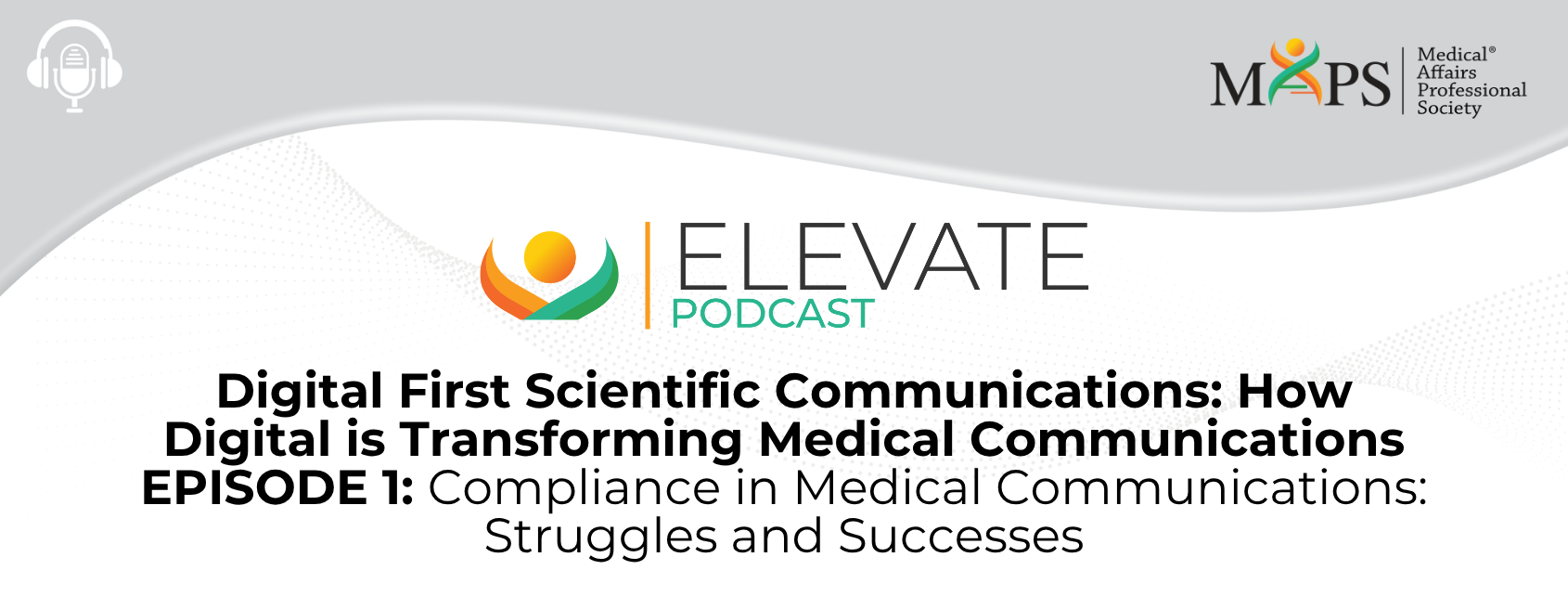Digital First Scientific Communications – How Digital is Transforming Medical Communications EPISODE 1:
Compliance in Medical Communications:
Struggles and Successes
Speaker: Jennifer Riggins
Speaker: Steve Casey
Speaker: Jeffrey W. Clemens
This podcast series focuses on how digital is transforming scientific communications. Season 2 Episode 1 will focus on the struggles and successes of compliance in Medical Communications. Season 2 Episode 2 will focus on the journal publishing industry, discussing how medical journal publishing is transforming and what changes we might see in the future. Season 2 Episodes 3 and 4 will focus on open access and how we can make scientific information more accessible and open access more transparent.
Description and Objectives:
Our podcast objectives are for listeners to better understand:
- Compliance issues and considerations facing publication professionals,
- The transparency complexities encountered by publication professionals
- And concerns related to the use of publications in downstream deliverables
Following is an automated transcription provided by otter.ai. Please excuse inaccuracies.
Jennifer Riggins 00:00
Welcome to the Medical Affairs professional society Digital Focus Area Working Group’s podcast series: Digital First Scientific Communication, How Digital is Transforming Medical Communication. In today’s episode, we will be discussing compliance and medical communication, the struggles and successes. I’m Jennifer Riggins, I’ll be the moderator for this podcast. I currently serve as a member of the Digital Focus Area Working Group. I’ve worked in pharma for almost 30 years with a focus on Medical Information, scientific communications and medical digital. I’m joined by Steve Casey of Omni Healthcare Communications a leader in digitally optimized medical communication.
Steve Casey 00:40
The views expressed in this recording are those of the individuals and do not necessarily reflect on the opinions of MAPS, or the companies of which they are affiliated. This presentation is for informational purposes only, and is not intended as legal or regulatory advice.
Jennifer Riggins 00:58
Our podcast objectives are for listeners to better understand compliance issues and consideration facing publication professionals, the transparency complexities encountered by publication professionals, and then concerns related to the use of publications in downstate streams deliverables. So today, we’ll be discussing compliance struggles and successes with Jeff Clemens. Jeff is the Senior Director for publication strategy and launch at Eli Lilly and Company. Welcome, Jeff, thanks for joining us today. Can you give us a brief background of your career and your current position?
Jeff Clemens 01:34
Yeah, thank you, Jennifer and Steve for inviting me here today. Glad to be able to share my experiences in scientific and medical communications. Like many folks in the medical and scientific writing world, I trained as a scientist earning my PhD in physiology at a large US research university. After postdoctoral training in Texas and a biology professorship in Pennsylvania. My family relocated to Indianapolis. Once there I began looking for opportunities and started at Lilly overnight. 10 years ago, I started as a publication writer, and I’ve worked in publications ever since. I’ve served as a writer, a publication planner, a subject matter expert for policies and procedures related to publications and disclosure and the system owner for a variety of publication management tools.
Steve Casey 02:18
Thanks so much, Jeff. Let’s jump right into it. Compliance is a big topic, so let’s try to narrow it down a bit. What are the main issues facing publications professionals with respect to compliance? Jeff?
Jeff Clemens 02:30
Thanks for the question, Steve. In publications, we generally don’t have the same level of external regulations and good practices that exist in the regulatory side of the biopharmaceutical business. There are no direct analogies to things like the International Committee for harmonization, or ich guidance, or the requirements of the FDA or the European Medicines Agency. But there are recommendations like those of the International Council of Medical Journal Editors, also known as ICM, J. More recently in August, the Annals of Internal Medicine, published a great update to the good publication practices for company sponsored biomedical research. This 2022 update, and its supplement touches many of the topics we’ll chat about today. In addition, both pharma and efpga have laid out some guidelines and most sponsors exceed them. I’m going to quickly summarize those here, that basically, the impact for publication planners have won. All company sponsored trials should be considered for publication, whether they’re considered to be positive or negative. And at a minimum, all phase three clinical trial results should actually be submitted for publication, and so should any other clinical trial results of significant medical importance. When I’m introducing new colleagues to writing and publication planning for sai coms, I kind of talk about three major areas or themes. One how to stay in the safe harbor of scientific exchange, when we are planning, writing, and engaging with authors or the journals, congresses, or the reviewers talking about our publications and how to use them appropriately to answer customers questions. For example, when if ever, is it okay to tweet about a publication. And then finally, transparency. Increasingly, our customers want more direct access to the materials and data, supporting our publications, whether they’re getting our information in a publication at a congress, say a presentation or a poster, or in a journal article. Journals and congresses also want more information about the relationships and activities of all authors, and all who were involved in a publication
Jennifer Riggins 04:46
So, Jeff, I think those are three great topics and I think we could do a podcast on each one of those individually. But let’s start with staying in the safe harbor of scientific data non promotion, talk it through Some of those examples of compliance considerations and struggles and successes you’ve had.
Jeff Clemens 05:05
Thanks, Jennifer, for. For me, one of the best ways to approach these issues is to think about the intent of why we do publications. If the research will answer an important question for customers and customers is HCPs. prescribers, payers, we have a variety of customers for our publications, then sharing the results in a congress or in a journal can consider to be a last step of the research process, so that science overall can advance with that purpose and intent in mind, it helps us to choose the appropriate venues, ones that are credible with the intended audience. So in practice, we like to pit congresses with some type of a competitive submission process, and journals with robust peer review, and that are respected by the customers. choices like these may mean, however, that we experience longer timelines during the process of peer review, in order to get that feedback and credibility, or we have to wait till there’s an abstract submission deadline, and the Congress is scheduled. But picking these venues helps keep us in that safe harbor of scientific exchange, and allows us to share information is protected free speech and the United States. Have to realize though, however, today’s customers may prefer other channels. Besides these traditional and long standing ones, podcasts like this one, video abstracts, and infographics can help the audience understand a trial much more quickly, but maybe less fully. It can be a challenge to maintain that commitment to getting the credibility of peer reviewed venues, and providing customers what they want, how they want it, and sooner rather than later. A related issue is social media. Social media is an evolving and sometimes murky area. For those involved in publications. It doesn’t have any peer review, which again helps create that safe harbor for scientific exchange, and the length limitations can restrict the complete fair and balanced discussion. In the US at least, regulatory authorities haven’t given definitive guidance on how biopharmaceutical companies and sponsors can engage in social media. However, since much the social media is used in a promotional way. When biopharma companies are discussing publications in those spaces, it may make the publication itself seem more promotional in its intent. Because of this concern, many pharma companies limit the ability of company employees to discuss publications and social media channels. Over more are doing limited postings in social media. From official company handles with considerations such as product, disease, state phase, the development, and marketing authorization, all factors to consider. Another issue that comes up in formats like video abstracts or infographics is the inherent limitations of that shorter format. It forces harder choices to make sure that the most important information is retained, and that safety and efficacy, benefits and risks and limitations are discussed in a full, transparent and balanced manner. We found a somewhat similar tension at times when we’re trying to create more visually appealing, concise, and focused posters and presentations for a congress. We’re continuing to make efforts to simplify our posters, but still provide enough context for a fair and balanced deliverable. Additionally, recently, several biomedically oriented preprint servers like med archive had been launched. And customers look for publication sooner now. And with less delays inherent in the traditional publication process journals. Again, one challenge here is that pure preprint servers are not peer reviewed. So we’re back again to possible concerns that sponsored research has not been peer reviewed, and therefore not covered by scientific exchange. Importantly, as well, publishers may view the research is less novel for the research. It’s already appeared on a preprint server. And additionally, many sponsors will now allow preprints about the research, but they often constrain it to non clinical content, or urgent communications, like therapies for COVID-19 During the recent and perhaps ongoing global pandemic.
Jennifer Riggins 09:32
Phew, that’s a lot. So those are some really great examples. So and I think are really critical shared learnings and important topics for consideration when choosing to use more novel formats and as your publication tactics. Transparency, I know is another big topic. So what kinds of transparency issues are publication writers facing? And how are they going about solving those issues?
Jeff Clemens 09:59
Jen, it’s it’s It’s another great question and a big issue for publication planners and writers. It’s been a topic of much discussion and some really important changes in the last decade, following changes that were important in the decade before that. One example about transparency is many journals now require a data sharing statement that will be published along with an accepted article. It describes how the data will be shared with folks who are not the authors and outside the site, the sponsor company. Therefore, many clinical research sponsors have a statement that outlines the process, whereby an interested investigator can submit a request on a third party site. Many sponsors use the same site. So it’s a very standard process. But the the central idea is that interested researchers can get access to data to answer specific scientific and medical questions. Some journals have come back to us and asked why, and the author’s why the data can’t be made more widely available on a open website without any other intermediary. Few issues, but one of which is that sponsors have an obligation to protect the privacy of clinical trial participants. So some type of control has to be in place to allow both those legitimate requests that will advance research knowledge, but continue to protect patient privacy. Another really big area of increased scrutiny is the relationships and activities of the authors involved in publications. Back in 2018, a very prominent us biomedical researcher at a top world class institution was the subject of headlines in the New York Times for reported failure to declare in journal articles, his relationships and activities with commercial sponsors. Now, ultimately, this is each author’s responsibility and journals vary wildly in their requirements on this topic, but this lack of uniformity can be confusing. So to create some uniformity and assist authors, for quite a few years now, the ICMJE has created a standard form that can be downloaded, and is accepted by some journals in lieu of any form that they may have. Generally, in the absence of any specific guidance from a journal or Congress, I always considered a best practice to ask the authors to complete the ICMJE form whenever they are involved in a publication with us as the sponsor. Authorship has some other important issues associated as well. Authorship is something of value to authors. Anytime that ACP is involved in a publication with a sponsor company, it is important to demonstrate that the intent is to gain their intellectual contribution and feedback as key opinion leaders are thought leaders. Otherwise, the authorship could be considered to be an earned by the ICM, J criteria, and could also be considered to be a reward to induce behaviors such as an endorsement of the product or as an actual payment for prescribing that therapy. This leads to charges providing kickbacks to healthcare providers. Therefore, many sponsors endorse and apply the ICMJE for parts that have criteria for authorship. These criteria emphasize the need for intellectual contribution and accountability by all authors, and transparent knowledge acknowledgement of all that are involved in publications. Recently, some consensus recommendations were published in the journal Current medical research and opinion that discuss how to evaluate contributions toward the first of the ICM, J criteria, which are about who is involved in the design of the research, data collection, the analysis and the interpretation. This article in CMRR earlier this year, and other available resources should help all parties get to a better understanding of the importance of following good authorship practices.
Steve Casey 14:10
There’s really a lot to think about their concerning transparency and working with external auditors, and our expectations and priorities versus those of the company. Jeff, the last area that we want to touch on today is the use of publications and medical deliverables, both medical deliverables and promotionally. What have you been dealing with from a compliance standpoint and using publications and downstream deliverables?
Jeff Clemens 14:36
Yeah, thanks. Thanks, Steve. This is an ongoing discussion. It happens. It happens quite frequently. But I’ll go back to near the beginning of our conversation here and the idea about the intent of a publication if our original intent is non promotional than downstream uses are generally okay. An important factor to consider however, is the timing of those downstream uses. And so you have to talk a little bit now about congresses in journalism their interests are. In general congresses in journals want to be the first to share data with their readers. Most journals will still consider data for publication and has already been presented to Congress so you don’t have any issues there. However, sharing data and results in promotional channels more than one or two times or at all, in some cases, may reduce the novelty and therefore the interest by the journals in publishing that particular journal article. In addition, both congresses and journals almost always have some type of a restriction or embargo on sharing the data once it is accepted, and before it is presented or published. But again, these policies vary a lot. In general, the higher tier or higher profile that a journal is, the stricter its embargo policies tend to be. So those top tier journals have the most strict usually, those embargo periods may mean that the data can’t be used or shared by the sponsor in any other channel, including press releases, investor and analyst calls, field medical staff, or inclusion in any sales or promotional materials. So publication planners need to be aware of the embargoes for their deliverables, and communicating with their Medical Affairs colleagues about any restrictions until the embargoes lift. In addition to embargo periods, an important consideration for Medical Affairs team is making sure that they’re complying with any other restrictions on information sharing in their country. And understanding that not all the information in a publication may be on label or aligned with a product insert, and then handling that accordingly.
Jennifer Riggins 16:42
Jeff, you have given us so much to think about and I think this has been a great discussion, Steve and I want to thank you for joining us today and answering our questions and providing these useful examples and synopsis of kind of what’s going on here in the the compliance field. I know that there is really an enormous amount more that we could cover and perhaps sometime in the future we’ll have a follow up episode to dive deeper into compliance considerations and struggles and successes. Until then, this has been Jennifer Riggins and Steve Casey, bringing you our fourth episode of digital first scientific communication, a podcast production of the Digital Focus Area Working Group at the Medical Affairs professional society.
Steve Casey 17:29
If you’re a MAPS member, thank you for your support. If you’re not yet a MAPS member and would like to access additional resources in this area, please visit the MAPS website to explore joining today at MedicalAffairs.org backslash membership. This concludes the podcast.






